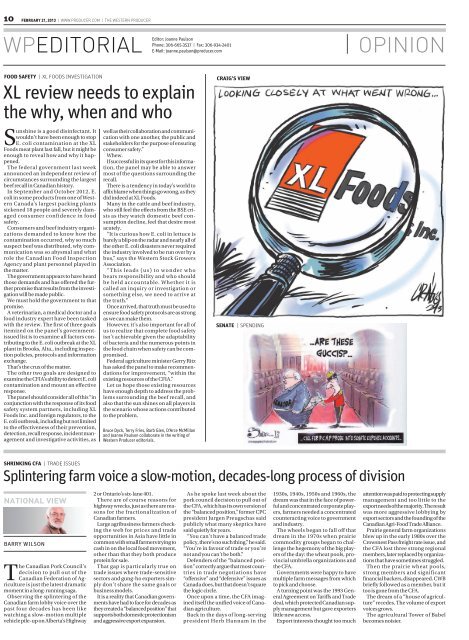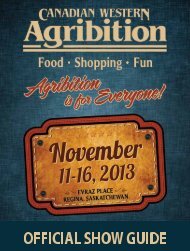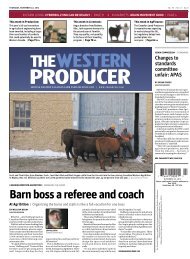10FEBRUARY 21, 2013 | WWW.PRODUCER.COM | THE WESTERN PRODUCERWPEDITORIALEditor: Joanne PaulsonPhone: 306-665-3537 | Fax: 306-934-2401E-Mail: joanne.paulson@producer.comOPINIONFOOD SAFETY | XL FOODS INVESTIGATIONXL review needs to explainthe why, when and whoSunshine is a good disinfectant. Itwouldn’t have been enough to stopE. coli contamination at the XLFoods meat plant last fall, but it might beenough to reveal how and why it happened.<strong>The</strong> federal government last weekannounced an independent review ofcircumstances surrounding the largestbeef recall in Canadian history.In September and October 2012, E.coli in some products from one of <strong>Western</strong>Canada’s largest packing plantssickened 18 people and severely damagedconsumer confidence in foodsafety.Consumers and beef industry organizationsdemanded to know how thecontamination occurred, why so muchsuspect beef was distributed, why communicationwas so abysmal and whatrole the Canadian Food InspectionAgency and plant personnel played inthe matter.<strong>The</strong> government appears to have heardthose demands and has offered the furtherpromise that results from the investigationwill be made public.We must hold the government to thatpromise.A veterinarian, a medical doctor and afood industry expert have been taskedwith the review. <strong>The</strong> first of three goalsitemized on the panel’s governmentissuedlist is to examine all factors contributingto the E. coli outbreak at the XLplant in Brooks, Alta., including inspectionpolicies, protocols and informationexchange.That’s the crux of the matter.<strong>The</strong> other two goals are designed toexamine the CFIA’s ability to detect E. colicontamination and mount an effectiveresponse.<strong>The</strong> panel should consider all of this “inconjunction with the response of its foodsafety system partners, including XLFoods Inc. and foreign regulators, to theE. coli outbreak, including but not limitedto the effectiveness of their prevention,detection, recall response, incident managementand investigative activities, aswell as their collaboration and communicationwith one another, the public andstakeholders for the purpose of ensuringconsumer safety.”Whew.If successful in its quest for this information,the panel may be able to answermost of the questions surrounding therecall.<strong>The</strong>re is a tendency in today’s world toaffix blame when things go wrong, as theydid indeed at XL Foods.Many in the cattle and beef industry,who still feel the effects from the BSE crisisas they watch domestic beef consumptiondecline, feel that desire mostacutely.“It is curious how E. coli in lettuce isbarely a blip on the radar and nearly all ofthe other E. coli disasters never requiredthe industry involved to be run over by abus,” says the <strong>Western</strong> Stock GrowersAssociation.“This leads (us) to wonder whobears responsibility and who shouldbe held accountable. Whether it iscalled an inquiry or investigation orsomething else, we need to arrive atthe truth.”Once arrived, that truth must be used toensure food safety protocols are as strongas we can make them.However, it’s also important for all ofus to realize that complete food safetyisn’t achievable given the adaptabilityof bacteria and the numerous points inthe food chain when safety can be compromised.Federal agriculture minister Gerry Ritzhas asked the panel to make recommendationsfor improvement, “within theexisting resources of the CFIA.”Let us hope those existing resourceshave enough depth to address the problemssurrounding the beef recall, andalso that the sun shines on all players inthe scenario whose actions contributedto the problem.Bruce Dyck, Terry Fries, Barb Glen, D’Arce McMillanand Joanne Paulson collaborate in the writing of<strong>Western</strong> <strong>Producer</strong> editorials.CRAIG’S VIEWSENATE | SPENDINGSHRINKING CFA | TRADE ISSUESSplintering farm voice a slow-motion, decades-long process of divisionNATIONAL VIEWBARRY WILSON<strong>The</strong> Canadian Pork Council’sdecision to pull out of theCanadian Federation of Agricultureis just the latest dramaticmoment in a long-running saga.Observing the splintering of theCanadian farm lobby voice over thepast four decades has been likewatching a slow-motion multiplevehicle pile-up on Alberta’s Highway2 or Ontario’s six-lane 401.<strong>The</strong>re are of course reasons forhighway wrecks, just as there are reasonsfor the fractionalization ofCanadian farmers.Large agribusiness farmers checkingthe web for prices and tradeopportunities in Asia have little incommon with small farmers trying tocash in on the local food movement,other than that they both produceprotein for sale.That gap is particularly true ontrade issues where trade-sensitivesectors and gung-ho exporters simplydon’t share the same goals orbusiness models.It is a reality that Canadian governmentshave had to face for decades asthey created a “balanced position” thatsupports both domestic protectionismand aggressive export expansion.As he spoke last week about thepork council decision to pull out ofthe CFA, which has its own version ofthe “balanced position,” former CPCpresident Jurgen Preugschas saidpublicly what many skeptics havesaid quietly for years.“You can’t have a balanced tradepolicy, there’s no such thing,” he said.“You’re in favour of trade or you’renot and you can’t be both.”Defenders of the “balanced position”correctly argue that most countriesin trade negotiations have“offensive” and “defensive” issues asCanada does, but that doesn’t squarethe logic circle.Once upon a time, the CFA imagineditself the unified voice of Canadianagriculture.Back in the days of long-servingpresident Herb Hannam in the1930s, 1940s, 1950s and 1960s, thedream was that in the face of powerfuland concentrated corporate players,farmers needed a concentratedcounteracting voice to governmentand industry.<strong>The</strong> wheels began to fall off thatdream in the 1970s when prairiecommodity groups began to challengethe hegemony of the big playersof the day: the wheat pools, provincialumbrella organizations andthe CFA.Governments were happy to havemultiple farm messages from whichto pick and choose.A turning point was the 1993 GeneralAgreement on Tariffs and Tradedeal, which protected Canadian supplymanagement but gave exporterslittle new access.Export interests thought too muchattention was paid to protecting supplymanagement and too little to theexport needs of the majority. <strong>The</strong> resultwas more aggressive lobbying byexport sectors and the founding of theCanadian Agri-Food Trade Alliance.Prairie general farm organizationsblew up in the early 1980s over theCrowsnest Pass freight rate issue, andthe CFA lost three strong regionalmembers, later replaced by organizationsthat have sometimes struggled.<strong>The</strong>n the prairie wheat pools,strong members and significantfinancial backers, disappeared. CWBbriefly followed as a member, but ittoo is gone from the CFA.<strong>The</strong> dream of a “house of agriculture”recedes. <strong>The</strong> volume of exportvoices grows.<strong>The</strong> agricultural Tower of Babelbecomes noisier.
THE WESTERN PRODUCER | WWW.PRODUCER.COM | FEBRUARY 21, 2013 11& OPEN FORUMINVESTMENT COMPANIES | FARMLANDAre our pensions retiring the family farm?BY MATT GEHLPension funds have started buyingup farmland around theworld in recent years, seeing itas a safe, long-term investment.Farmland investment companiessuch as AgCapita, Assiniboia Capital,Bonnefield Financial and PrairieMerchants are sowing the seeds ofspeculation across the Prairies.Saskatchewan, with our low landprices and a farming populationaveraging 58 years old, is shaping upto be fertile ground for these companies.Hundreds of thousands of acres ofSaskatchewan farmland are alreadyunder the management of theseinvestment companies.Several seek to attract institutionalinvestors such as pension funds andRRSP-eligible mutual funds tofinance further land purchases.AgCapita, which as of 2011 hadbought $12.8 million of Saskatchewanfarmland, is RRSP eligible.Two RRSP mutual funds, GoldenOpportunities and SaskWorks, haveinvested in farmland investmentfunds.SaskWorks has invested $20 millionwith Agco Ag Ventures, andGolden Opportunities has funneled$3.5 million into Assiniboia Capital(via ADC Enterprises) as well asanother $2.5 million into InputCapital Limited Partnerships, a divisionof Assiniboia.Some of the financing forAssiniboia Capital’s acquisition ofmore than 115,000 acres across Canadahas been provided by FarmCredit Canada, which is funded byOttawa and pays dividends to thefederal government.Pensions invested in land are good for retiring farmers as land pricesrise but create hardships for farmers wanting to expand. | FILE PHOTORetiring farmers, and those sufferingunder the high debt levels seeminglyinherent to modern farming,are targeted by these companies.<strong>The</strong>y rent the land back to farmerswhile waiting for the selling price torise to sufficiently profitable levels.Usually this is done on a cash rentbasis, where all of the day-to-day riskof farming is borne solely by the rentingfarmer.This situation has similarities tothat in Europe of the 19th century,which is what led many Europeans touproot their families and escape tosettle in Canada.Retiring farmers are faced with achoice: pass their land onto anotherfamily farmer, possibly taking lessthan the maximum value, or sell tothe highest bidder with no concernfor the legacy of the land.Under this new system, retiringfarmers should be happy in theirtwilight years, urban residents withpensions invested in farmland willbe happy with the long-term outlookof their retirement money and theland grabbing companies will happilytake their cut as land values andrents keep rising.But how do we expect young Canadiansto consider becoming farmers?<strong>The</strong> reality is that today there are notenough young farmers. Farmersyounger than 35 represent only eightpercent of the farming population,raising the question of who will workthe land in the future? Who will growour food?This is where the long-term visionof retirement planning seems to havea blind spot. Speculation aroundfarmland is already putting the costof land out of reach for many individualfarmers looking to either startor expand an operation, leavinginvestment companies with millionsof dollars in capital in an even betterposition to increase their land holdings.If more of them are able to generateinvestment dollars through RRSPs, itwill further this cycle.Policies and tax breaks that encourageCanadians to plan responsiblyfor their retirements are essential,but there is a clear lack of planningfor the next generation of farmers.Family farms have been the backboneof Canadian agriculture for ourentire history and now they are beingpriced out of the market for the mostessential of assets: the land.Without a plan and policies inplace to ensure that the next generationof Canadians can carry on ourproud farming tradition, the onlyfuture in store for Canadian agricultureis one occupied only by the largest,most corporate farms sparselyscattered over an increasingly emptyprairie.This is not a future that bodes wellfor Canadian food security and sovereignty,and it certainly does notlook promising for family farms.That is not a future I want to see inCanada.Matt Gehl, 28, is a National FarmersUnion board member who farmsgrain with his family near Regina.This op ed has been edited for length.CROP INSURANCE | PROGRAM IMPROVEMENTSSask. Crop Insurance could learn from AlbertaHURSH ON AGKEVIN HURSHCrop insurance is a great programand it doesn’t get thepraise it deserves. However, itcould be even better with relativelyminor adjustments. Saskatchewanshould take a look at what Albertaoffers.<strong>The</strong> federal and Saskatchewan governmentscan rightly claim credit fora number of program enhancementsthis year.Yield trending has improved thecoverage levels for hard red and hardwhite spring wheat, along with oats.As well, more Saskatchewan producersare eligible to insure soybeans,and the establishment benefits forcanola and field peas have beenincreased.However, the main improvementcomes from higher grain prices ratherthan any government decision.<strong>The</strong> average coverage level is a recordhigh $194 per acre, up from $174 lastyear and more than double the coverageoffered in 2007.In 2012, the insured price for canolawas $11.11 a bushel. This year it willbe $12.36. Hard red spring wheat was$5.14 a bu. last year and is now $6.80.Peas have gone from $6.93 to $7.43.A few crops are going the otherdirection. Large green lentils aredropping from 22 cents a pounddown to 20 cents. <strong>The</strong> biggest drop ison chickpeas with the large kabulitype falling from 38.5 cents a lb. to 29cents.Overall though, the price outlookwas higher for most crops in December2012 than in December 2011.That’s why overall crop insurancecoverage has jumped.To its credit, Saskatchewan CropInsurance has a contract priceoption. If you lock in a favourableprice on part of the crop you hope togrow, that contract price can be usedto increase your insured price.Conversely, the variable priceoption being offered has little attraction.A July price forecast is usedwith the variable price option, soyou get to insure at a price closer toharvest time values. <strong>The</strong> problemcomes from how premiums arehandled.At one time, the premium went upor down corresponding to whetherthe variable price ended up higher orlower. Now, producers choosing thevariable price option pay a higherpremium up front, but their coveragemight go up or down depending onwhat happens with the price of thecrop.Who wants to pay a higher premiumwhen you could end up withcoverage dropping by as much as 50percent?Alberta has this figured out. It offersa variable price benefit on most cropsat no additional cost. If the price inthe fall is higher than the spring price,producers receive the higher coverageautomatically. And Alberta usesan October price, making it morerelevant than the July price used inSaskatchewan.Alberta has also been offering aprogram that it funds jointly withproducers without any federal support.Called the spring price endorsement,it is price insurance rather thanproduction insurance. Enrolled producersget a payment If the Octoberprice is more than 10 percent lowerthan the spring price.If a producer has a 40 bu. per acreaverage yield on barley and chooses80 percent yield coverage, the cropinsurance yield guarantee is 32 bu.an acre.Let’s say the producer grows morethan 40 bu. per acre, but the price ofbarley drops from $4.35 a bu. in thespring to $3.75 in the fall. <strong>The</strong> produceris paid the 60 cents differenceon 32 bu. per acre.Only in Alberta. Pity.Kevin Hursh is an agricultural journalist,consultant and farmer. He can be reached bye-mail at kevin@hursh.ca.POLITICS | SENATEMP watchdogsare taking biteout of taxpayerEDITORIAL NOTEBOOKJOANNE PAULSON, EDITOROnce a student of politicalscience, I was generally prettyimpressed with the wayour government was set up — at leastin theory.You have your representativehouse of elected folks. You haveyour second house of non-electedfolks, who don’t have to worry aboutpleasing voters, to keep an eye onthe elected folks. <strong>The</strong>n, for goodmeasure, you have your representativeof the head of state, the governorgeneral.When I got a bit less starry eyedabout the whole democracy thing, Irealized that the GG , from a keepingCanada intact standpoint, was prettyuseless. It’s a nice figurehead, but aGG would really have to step out ofhis or her zone to make any politicaldifference in this country.Oh well, I thought. At least we stillhave senators to keep an eye on thoseMPs. Good thing they’re not elected,or everyone running this countrywould be luring the populace withpromises.Lately, though, I’ve been a littleannoyed with some of those senators,who clearly feel the world owesthem a living.Patrick Brazeau would be the No. 1annoyance. He has been chargedwith assault and sexual assault. Thisis the sort of person we want in thered chamber?At least the Senate has booted himfor the time being, but he’s still makinghis 130 grand.Granted, one is innocent untilproven guilty, and we must wait forthe legal system to work, but I justdon’t know about paying someonenot to show up for work.<strong>The</strong>n there are the other senatorswho may, or may not, live in theregions they represent. Mike Duffymay or may not live in Prince EdwardIsland, for example, and is beingaudited for claiming special expensesfor a second residence.Of greatest interest to the West isPamela Wallin, famously fromWadena, Sask., whose expenses arealso now being checked by an outsideauditing firm.Do we care where senators live? Ithink we should, for if they do notvisit us from time to time, how wouldthey know what we, the people intheir regions, need? And if that’s notimportant, why are senatorsappointed from the various regionsof Canada in the first place?<strong>The</strong> big downside to all thesealleged shenanigans among senators?You can’t vote them out whenthey really make you cranky.
- Page 1 and 2: THURSDAY, FEBRUARY 21, 2013 VOL. 91
- Page 3 and 4: NEWS THE WESTERN PRODUCER | WWW.PRO
- Page 5 and 6: NEWS THE WESTERN PRODUCER | WWW.PRO
- Page 7 and 8: MARKETS THE WESTERN PRODUCER | WWW.
- Page 9: MARKETS THE WESTERN PRODUCER | WWW.
- Page 13 and 14: OPINION THE WESTERN PRODUCER | WWW.
- Page 15 and 16: NEWS THE WESTERN PRODUCER | WWW.PRO
- Page 17 and 18: NEWSTHE WESTERN PRODUCER | WWW.PROD
- Page 19 and 20: NEWSTHE WESTERN PRODUCER | WWW.PROD
- Page 21 and 22: THE WESTERN PRODUCER | WWW.PRODUCER
- Page 23 and 24: FARM LIVINGTHE WESTERN PRODUCER | W
- Page 25 and 26: FARM LIVINGTHE WESTERN PRODUCER | W
- Page 27 and 28: THE WESTERN PRODUCER | WWW.PRODUCER
- Page 29 and 30: NEWSTHE WESTERN PRODUCER | WWW.PROD
- Page 31 and 32: NEWSTHE WESTERN PRODUCER | WWW.PROD
- Page 33 and 34: RESEARCH | PHOTOSYNTHESISBY MARY MA
- Page 35 and 36: NEWSTHE WESTERN PRODUCER | WWW.PROD
- Page 37 and 38: NEWSTHE WESTERN PRODUCER | WWW.PROD
- Page 39 and 40: THE WESTERN PRODUCER | WWW.PRODUCER
- Page 41 and 42: THE WESTERN PRODUCER | WWW.PRODUCER
- Page 43 and 44: NEWSTHE WESTERN PRODUCER | WWW.PROD
- Page 45 and 46: NEWSTHE WESTERN PRODUCER | WWW.PROD
- Page 47 and 48: NEWSTHE WESTERN PRODUCER | WWW.PROD
- Page 49 and 50: THE WESTERN PRODUCER | WWW.PRODUCER
- Page 51 and 52: THE WESTERN PRODUCER | WWW.PRODUCER
- Page 53 and 54: THE WESTERN PRODUCER, THURSDAY, FEB
- Page 55 and 56: THE WESTERN PRODUCER, THURSDAY, FEB
- Page 57 and 58: THE WESTERN PRODUCER, THURSDAY, FEB
- Page 59 and 60: THE WESTERN PRODUCER, THURSDAY, FEB
- Page 61 and 62:
THE WESTERN PRODUCER, THURSDAY, FEB
- Page 63 and 64:
THE WESTERN PRODUCER, THURSDAY, FEB
- Page 65 and 66:
THE WESTERN PRODUCER | WWW.PRODUCER
- Page 67 and 68:
AstroOVER400CAR & TRUCK SALES LTD.
- Page 69 and 70:
HUGEBLOWOUT!SAVE BIG!2011 FORD F150
- Page 71 and 72:
THE WESTERN PRODUCER, THURSDAY, FEB
- Page 73 and 74:
THE WESTERN PRODUCER, THURSDAY, FEB
- Page 75 and 76:
THE WESTERN PRODUCER, THURSDAY, FEB
- Page 77 and 78:
THE WESTERN PRODUCER, THURSDAY, FEB
- Page 79 and 80:
THE WESTERN PRODUCER, THURSDAY, FEB
- Page 81 and 82:
THE WESTERN PRODUCER, THURSDAY, FEB
- Page 83 and 84:
THE WESTERN PRODUCER, THURSDAY, FEB
- Page 85 and 86:
NEWSTHE WESTERN PRODUCER | WWW.PROD
- Page 87 and 88:
THE WESTERN PRODUCER | WWW.PRODUCER
- Page 89 and 90:
PRODUCTIONTHE WESTERN PRODUCER | WW
- Page 91 and 92:
PRODUCTIONTHE WESTERN PRODUCER | WW
- Page 93 and 94:
NEWSTHE WESTERN PRODUCER | WWW.PROD
- Page 95 and 96:
THE WESTERN PRODUCER | WWW.PRODUCER
- Page 97 and 98:
LIVESTOCKTHE WESTERN PRODUCER | WWW
- Page 99 and 100:
LIVESTOCKTHE WESTERN PRODUCER | WWW
- Page 101 and 102:
AGFINANCETHE WESTERN PRODUCER | WWW
- Page 103 and 104:
WEATHERTHE WESTERN PRODUCER | WWW.P








